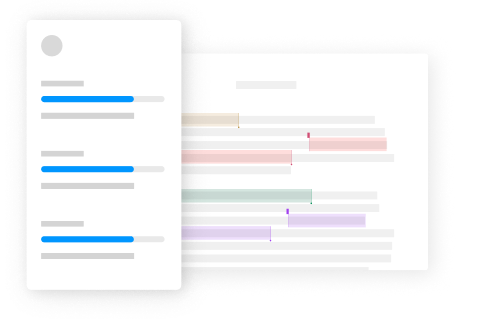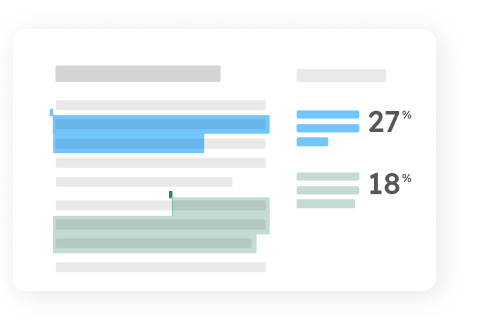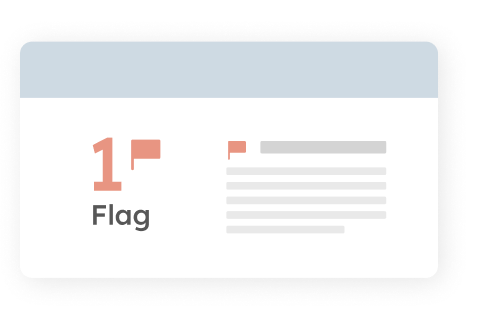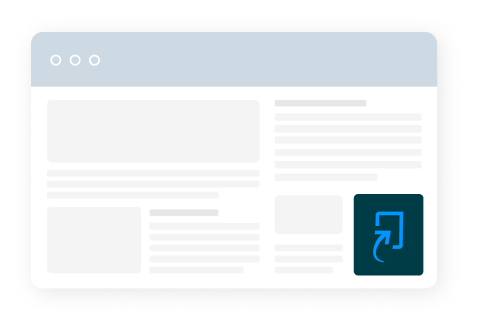
Comprehensive plagiarism detection with
Turnitin Similarity
Protect against plagiarism and student collusion to safeguard your institution’s reputation and teach the value of original writing.
Unlock the benefits of Turnitin Similarity

Protect your reputation
Avoid the lasting damage of academic misconduct and uphold academic standards by identifying when likely instances of plagiarism are present in student writing.

Safeguard academic integrity
Transform plagiarism into a teachable moment by guiding students on how to maintain originality, helping them understand the ethical use of sources.

Streamline your institutional workflows
Boost productivity by adopting a solution that integrates effortlessly into your institution’s existing workflows, reducing administrative burdens and enhancing the overall educational experience.

How Turnitin Similarity upholds academic integrity in every assignment

Comprehensive database
Assess originality with the Similarity Report, which compares student work against a vast collection of student submissions, premium publications, and 20+ years of internet content—all in an intuitive, integrated interface.

Enhanced Similarity Report
View an assignment’s similarity score and get color-coded results and side-by-side comparisons to sources. Plus, exclude any unnecessary matches to further refine the report.

Similarity flags panel
Go deeper into a document to assess whether a student has made text modifications such as white text, inserted characters, and character swapping to circumvent plagiarism checks.

Seamless integration
Turnitin Similarity integrates with all the top learning management systems, collaboration tools, and single-sign-on services.
Ready to talk? Chat with an expert.
Schedule a callChoose the Turnitin Similarity features that work for you
Core features
Enhanced Similarity Report with Match Group categorization* for clearer organization of matches and quicker interpretation of results
Flags Panel highlighting potentially manipulated text such as replaced or hidden characters.
Compare work against an unparalleled repository of student papers, current and archived web pages, and premium subscription articles from top publishers across 170 languages
Formative resubmissions via LMS
Exclude templates (e.g, a cover sheet or instructions, questions, and tables in an assignment) from the Similarity Report via LTI integration
Add-ons
Turnitin Originality: AI writing and AI paraphrasing detection, insights into contract cheating, and ProQuest Theses and Dissertations database access
*Feature available in English only
“With Turnitin … teachers can check similarity from one platform. We expect to see a lot more teachers using Turnitin, more of the time. This is important because integrity is a core value at Hale. Therefore, it is important that students understand the importance of original thought and original pieces, and that they are being held accountable for the work they submit.”
Rob Barugh, Director of Learning Technologies, Hale School, Perth
Who Turnitin Similarity supports

Students
Help students understand similarities between their work and existing sources, providing an opportunity to correct integrity issues such as citation or paraphrasing errors and improve the originality of their work before final submission.

Instructors
Compare student work against an unparalleled content database, using the Similarity Report to review and filter matches and flag attempts to bypass similarity checks. Guide students toward better research and writing practices and turn plagiarism into a teachable moment.

Administrators
Equip instructors to identify potential plagiarism at scale as part of their existing workflow. Promote a culture of academic integrity and mitigate the risk of reputational damage from undetected cases of plagiarism and student collusion.
Seamless integration with your institution’s ecosystem
Turnitin Similarity can be used through the web, integrated natively or via API and LTI 1.3 into most popular Learning Management Systems. This includes D2L, Canvas, Microsoft Teams, Moodle, Sakai, and others, fitting seamlessly into student, instructor, and administrator workflows. Turnitin vigorously protects your personal data and works hard to achieve extremely high levels of security, including GDPR compliance. Data is stored with robust physical, digital, and procedural safeguards in place, including the use of SSL encryption, redundant servers, and SOC2-certified data centers.
Ready to talk?
Chat with an expert.
Your Turnitin Similarity questions answered
Collapse all
Does Turnitin Similarity detect plagiarism?
Turnitin Similarity is a tool to support the detection of plagiarism by flagging instances of text similarity that may constitute plagiarism; however, it does not determine whether plagiarism has occurred. Each Similarity Report and its similarity score—the percentage of matching or similar text that has been uncovered—serves to equip educators with powerful insights to make their own, informed judgment call on whether a student’s content is plagiarized and if it was likely intentional or inadvertent and borne from a skill gap. Access on-paper highlights, filtration options, and flag insights that allow users to scrutinize the source of text matches and identify discrepancies, such as replaced characters or hidden text.
How does Turnitin generate a Similarity Report?
When a paper is submitted to Turnitin, a detailed Similarity Report is generated by breaking down text into phrases with assigned IDs and comparing them against seven trillion matches in Turnitin’s comprehensive database, including internet articles, scholarly publications, and student papers. Using natural language processing and strict matching techniques, Turnitin algorithm minimises false positives and flags unusual content for review. Alongside Turnitin’s default settings, the Similarity Report’s degree of accuracy further depends on user-configured settings, which allow educators to refine the percentage-based similarity score to align with their assignment requirements.
How should institutions interpret the Similarity Report’s similarity score?
The Similarity Report’s similarity score is the percentage of text in a submission that matched against other sources. If students use any text from source material to support their work, such as a quote, it will be reflected in this score. Instructors have the option to use the report’s match exclusion feature to exclude citations or bibliographic information from affecting a student’s score. Your institution may or may not have assigned a number as an acceptable threshold for assignments, but keep in mind that there is no ‘right’ or ‘wrong’ number to receive as a score. Use the report insights and score within your review process to understand a student’s reliance on source material and make your own determination if any plagiarism or improper attribution is present.
How does the Similarity Report support formative feedback and better student writing practices?
While the Similarity Report is a great resource to check student work for possible plagiarism, the true power of the report is realized when it’s used as a formative assessment tool to strengthen academic writing skills and improve learning outcomes. Utilize details and data from a student’s paper and report to have an informed conversation about how they can make changes to improve. For instance, use the report to identify any areas that are exceptionally heavy on similar text to have an informed dialogue with students on how to improve. Consider conducting a lesson to review with students effective quoting, paraphrasing, and summarizing, and ask them to rewrite that section of text, reducing the amount of similar text within their writing.
Does Turnitin Similarity include AI writing detection?
Turnitin Similarity customers can access AI writing detection through our product add-on, Turnitin Originality. Once enabled, Turnitin’s AI writing indicator is linked to the Similarity Report and shows an overall percentage of the document that AI writing tools such as ChatGPT may have generated. It also includes the detection of AI-generated content that may have been paraphrased using a text spinner.* With intuitive navigation, users can easily switch between different report functionalities, such as the flags panel and integrated AI writing report. View aggregated AI scores across submissions over a period of time to understand the scale of usage.
*Feature available in English only




